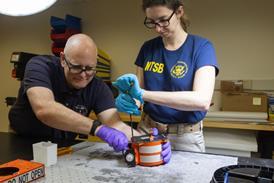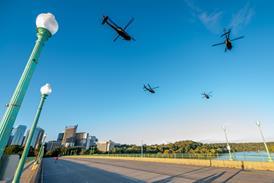The US Army is pursuing a high-energy laser (HEL) capability for its rotorcraft and fixed-wing assets, following a successful test on a Boeing AH-64 Apache attack helicopter.
Raytheon is looking to meet US Army Aviation’s specifications for the airborne laser capability, Ben Allison, the company's product lead for HEL told FlightGlobal at the AUSA annual meeting in Washington DC. Raytheon previously worked on a separate directed-energy effort led by the US Special Operations Command (SOCOM), which tested a high-energy laser aboard an Apache. The test emerged out of a co-operative research development agreement between the contractor, SOCOM and the Apache programme office.
The experiment marked the first time a laser hit a target from a rotary-wing aircraft, Raytheon announced on 27 September. The HEL system combined a laser pod with a modified version of the company’s multi-spectral targeting system electro-optical/infrared sensor, which directed the beam and engaged the target.
Raytheon displayed a ground-based version of the system mounted on a tactical vehicle at AUSA. In a video demonstration, the ground-based HEL destroys a small quadcopter by cutting away part of the unmanned air vehicle's structure. Unlike a microwave technology that would fry electronics, the HEL can go after sensors, blind a target or physically destroy it.
An airborne laser capability may not be a near-term possibility though, Apache programme manager Col Joe Hoecherl cautions. While the US Army will be ready for directed-energy technology, the service is still working to understand the policy behind employing laser weapons, he says.
“It’s a capability we’re interested in,” Hoecherl says. “But it’s still very early from a policy in how we use lasers and ways to make sure we do everything properly, legally. You have a whole lot of things factored in that are far outside the materiel development realm. How do you do it in a safe manner?”
Source: FlightGlobal.com


























